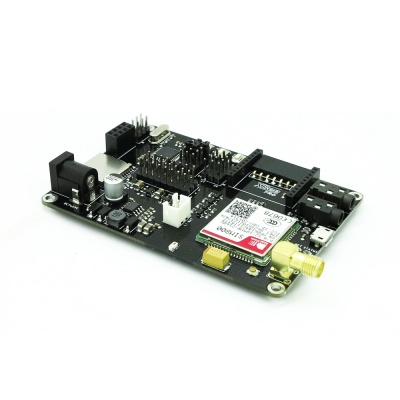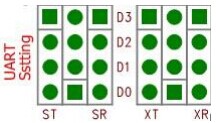Gboard 800
Contents
Overview
Gboard 800 is a unique Arduino board which features a SIM800 GSM/GPRS/BT module, an XBee socket, nRF24L01+ module interface and an ATMega328P controller. This board can be added wireless XBee / nRF24L01+ control as well as GSM/GPRS connectivity to your projects. It’s great for anything from home automation to robot control. The possibilities are endless!
Gboard 800 can be used as a GSM/GPRS data transfer or wireless communication project development platform. Gboard supports wide range power supply and Micro SD for mass storage. There are some 3pin electronic brick/ sensor brick interface breakout on board, which offers an easy way for a quick prototyping. The board requires FTDI basic board to upload sketch, you can use our Foca board to do it.
Note:
- Gboard 800 has a micro USB connector only for debugging or firmware uploading.
- When you upload sketch to Gboard, please choose the board Arduino Duemilanove w/ ATmega328.
- The bootloarder file is ATmegaBOOT_168_atmega328.hex, you can find it in the directory arduino\hardware\arduino\bootloaders\atmega
- The serial interface (bootloader connection) is 3.3v, not the typical 5v as on many Arduino boards - anyone using an alternative to the Foca board must take note not to risk damage.
Specification
| PCB size | 88.1mm X 60.7mm X 1.6mm |
| Power supply | 7-23V DC |
| Microprocessor | Atmega328 |
| Indicators | PWR, Status, NET |
| RoHS | Yes |
Electrical Characteristics
| Specification | Min. | Typical Value | Max. | Unit |
|---|---|---|---|---|
| Power Voltage | 7 | - | 23 | VDC |
| Input Voltage VH (Target Voltage = 3.3V) | 3 | 3.3 | 3.6 | V |
| Input Voltage VL: | -0.3 | 0 | 0.5 | V |
| Current Consumption | - | 100 | 500 | mA |
Hardware
Note:
- Baterry Socket: you can connect a Li-ion battery onto the socket to power the board up instead of DC external power supply, the input voltage is from 3.4V~4.4V.
- Debug Port: it is a debugging interface for SIM800 so that you can upgrade firmware and debug software.
Pin Map
- Nrf24L01 Socket
| Index of Interface | Name of Interface | Index of Arduino |
| 1 | GND | - |
| 2 | 3V3 | |
| 3 | CE | D8 |
| 4 | CS | D9 |
| 5 | SCK | D13 |
| 6 | MOSI | D11 |
| 7 | MISO | D12 |
| 8 | IRQ | - |
- SD Card Socket
| Index of Interface | Name of Interface | Index of Arduino |
| 1 | SD_CS | D10 |
| 2 | SD_MOSI | D11 |
| 3 | 3V3 | - |
| 4 | SD_SCK | D13 |
| 5 | GND | - |
| 6 | SD_MISO | D12 |
UART Setting Jumpers
The SIM800 module and XBee module communicate to Atmega 328 through UART. Because they could not communicate in same port in the same time, there are two UART setting jumpers to configure the UART communication. The figure of UART setting jumpers is as below.
(Figure of UART setting jumpers)
D0 and D1 are hardware UART ports of Arduino. D2 and D3 are digital GPIO of Arduino. There are two configurations to set the UART communication.
ST: UART Tx of SIM900 module
SR: UART Rx of SIM900 module
XT: XBee Tx of XBee module
XR: XBee Rx of XBee module
Power and reset connection of SIM800
In the GBoard, the PWRKEY and RESET pins of SIM800 module connect to Arduino as list below.
| Arduino pin | SIM800 pin | Enable |
|---|---|---|
| D6 | PWR | High level Active |
| D7 | RESET | High level Active |
Revision History
| Rev. | Description | Release date |
| v1.0 | Initial version | 2014-12-10 |
 Notice
Notice


